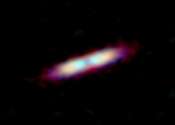Stellar 'ashfall' could help distant planets grow
The world's first 3D simulation simultaneously considering dust motion and growth in a disk around a young star has shown that large dust from the central region can be entrained by and then ejected by gas outflows, and eventually ...









